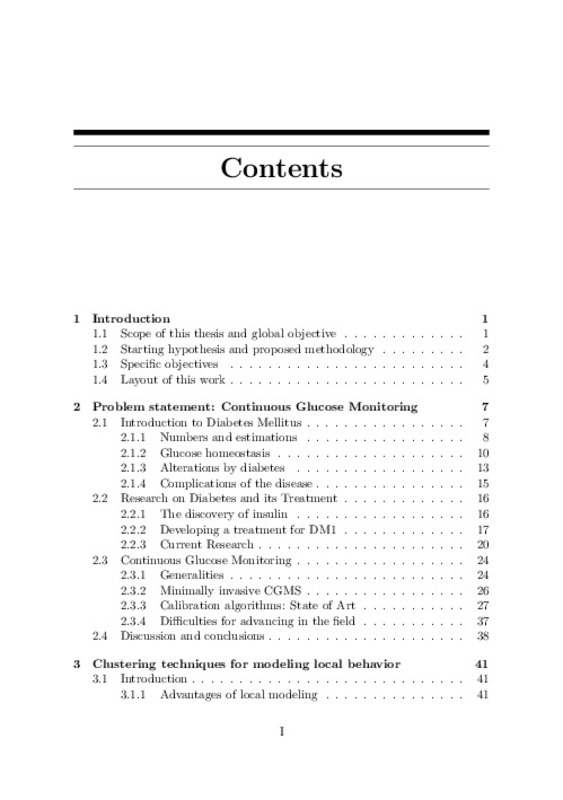- RiuNet repositorio UPV
- :
- Investigación
- :
- Tesis doctorales
- :
- Ver ítem
JavaScript is disabled for your browser. Some features of this site may not work without it.
Buscar en RiuNet
Listar
Mi cuenta
Estadísticas
Ayuda RiuNet
Admin. UPV
Multimodel Approaches for Plasma Glucose Estimation in Continuous Glucose Monitoring. Development of New Calibration Algorithms
Mostrar el registro sencillo del ítem
Ficheros en el ítem
| dc.contributor.advisor | Diez Ruano, José Luís
|
es_ES |
| dc.contributor.advisor | Bondía Company, Jorge
|
es_ES |
| dc.contributor.author | Barceló Rico, Fátima
|
es_ES |
| dc.date.accessioned | 2012-09-20T06:42:01Z | |
| dc.date.available | 2012-09-20T06:42:01Z | |
| dc.date.created | 2012-06-14T08:00:00Z | es_ES |
| dc.date.issued | 2012-09-20T06:41:57Z | es_ES |
| dc.identifier.uri | http://hdl.handle.net/10251/17173 | |
| dc.description.abstract | ABSTRACT Diabetes Mellitus (DM) embraces a group of metabolic diseases which main characteristic is the presence of high glucose levels in blood. It is one of the diseases with major social and health impact, both for its prevalence and also the consequences of the chronic complications that it implies. One of the research lines to improve the quality of life of people with diabetes is of technical focus. It involves several lines of research, including the development and improvement of devices to estimate "online" plasma glucose: continuous glucose monitoring systems (CGMS), both invasive and non-invasive. These devices estimate plasma glucose from sensor measurements from compartments alternative to blood. Current commercially available CGMS are minimally invasive and offer an estimation of plasma glucose from measurements in the interstitial fluid CGMS is a key component of the technical approach to build the artificial pancreas, aiming at closing the loop in combination with an insulin pump. Yet, the accuracy of current CGMS is still poor and it may partly depend on low performance of the implemented Calibration Algorithm (CA). In addition, the sensor-to-patient sensitivity is different between patients and also for the same patient in time. It is clear, then, that the development of new efficient calibration algorithms for CGMS is an interesting and challenging problem. The indirect measurement of plasma glucose through interstitial glucose is a main confounder of CGMS accuracy. Many components take part in the glucose transport dynamics. Indeed, physiology might suggest the existence of different local behaviors in the glucose transport process. For this reason, local modeling techniques may be the best option for the structure of the desired CA. Thus, similar input samples are represented by the same local model. The integration of all of them considering the input regions where they are valid is the final model of the whole data set. Clustering is t | es_ES |
| dc.language | Inglés | es_ES |
| dc.publisher | Universitat Politècnica de València | es_ES |
| dc.rights | Reserva de todos los derechos | es_ES |
| dc.source | Riunet | es_ES |
| dc.subject | Diabetes | es_ES |
| dc.subject | Continuous glucose monitoring | es_ES |
| dc.subject | Clustering | es_ES |
| dc.subject | Local models | es_ES |
| dc.subject | Calibration algorithm | es_ES |
| dc.subject | Individualization | es_ES |
| dc.subject.classification | INGENIERIA DE SISTEMAS Y AUTOMATICA | es_ES |
| dc.title | Multimodel Approaches for Plasma Glucose Estimation in Continuous Glucose Monitoring. Development of New Calibration Algorithms | |
| dc.type | Tesis doctoral | es_ES |
| dc.identifier.doi | 10.4995/Thesis/10251/17173 | es_ES |
| dc.rights.accessRights | Abierto | es_ES |
| dc.contributor.affiliation | Universitat Politècnica de València. Departamento de Ingeniería de Sistemas y Automática - Departament d'Enginyeria de Sistemes i Automàtica | es_ES |
| dc.description.bibliographicCitation | Barceló Rico, F. (2012). Multimodel Approaches for Plasma Glucose Estimation in Continuous Glucose Monitoring. Development of New Calibration Algorithms [Tesis doctoral no publicada]. Universitat Politècnica de València. https://doi.org/10.4995/Thesis/10251/17173 | es_ES |
| dc.description.accrualMethod | Palancia | es_ES |
| dc.type.version | info:eu-repo/semantics/acceptedVersion | es_ES |
| dc.relation.tesis | 3821 | es_ES |
Este ítem aparece en la(s) siguiente(s) colección(ones)
-
Tesis doctorales [5284]







![Text file [Text]](/themes/UPV/images/text.png)


